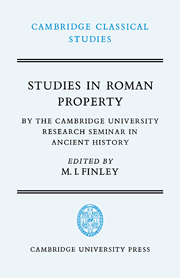Book contents
- Frontmatter
- Contents
- Preface
- 1 INTRODUCTION
- 2 SOME CONFIGURATIONS OF LANDHOLDING IN THE ROMAN EMPIRE
- 3 IMPERIAL ESTATES
- 4 CLASSICAL ROMAN LAW AND THE SALE OF LAND
- 5 THE CICERONIAN ARISTOCRACY AND ITS PROPERTIES
- 6 PRIVATE FARM TENANCY IN ITALY BEFORE DIOCLETIAN
- 7 URBAN PROPERTY INVESTMENT
- 8 AGRI DESERTI
- Notes
- Bibliography
- Index
5 - THE CICERONIAN ARISTOCRACY AND ITS PROPERTIES
Published online by Cambridge University Press: 05 June 2014
- Frontmatter
- Contents
- Preface
- 1 INTRODUCTION
- 2 SOME CONFIGURATIONS OF LANDHOLDING IN THE ROMAN EMPIRE
- 3 IMPERIAL ESTATES
- 4 CLASSICAL ROMAN LAW AND THE SALE OF LAND
- 5 THE CICERONIAN ARISTOCRACY AND ITS PROPERTIES
- 6 PRIVATE FARM TENANCY IN ITALY BEFORE DIOCLETIAN
- 7 URBAN PROPERTY INVESTMENT
- 8 AGRI DESERTI
- Notes
- Bibliography
- Index
Summary
Much of the information about the real property of the Roman aristocracy in the Late Republic has already been carefully collected and listed. This chapter does not aim at any sort of completeness; it attempts to make some points, hitherto insufficiently stressed or entirely neglected, about the attitudes which the senatorial class held to its estates, what types of property it preferred (or was permitted) to invest in, and how it assisted its dependants to invest; with the little that can be said about prices and their variations, and about dealers in real property.
From the corpus of Cicero's letters we get an impression of the Roman upper class as not only deeply concerned with real property, its main form of investment, but indeed feverishly engaged in property deals. This impression may not be wholly misleading, in spite of the fact that Cicero and his brother Quintus were, for most of the period covered by the letters, rising in the social and economic scale, and thus particularly prone to buying or considering buying property. One must recognize that there were a number of reasons for a hectic turnover: one, obviously, the civil wars and proscriptions of the 80s and 40s, with, in between, the comparative frequency with which senators succumbed to prosecutions leading to exile and, if not always to the confiscation of their estates, at any rate to the need to make new dispositions of their property (or at long last to pay their creditors).
- Type
- Chapter
- Information
- Studies in Roman PropertyBy the Cambridge University Research Seminar in Ancient History, pp. 85 - 102Publisher: Cambridge University PressPrint publication year: 1976
- 24
- Cited by

